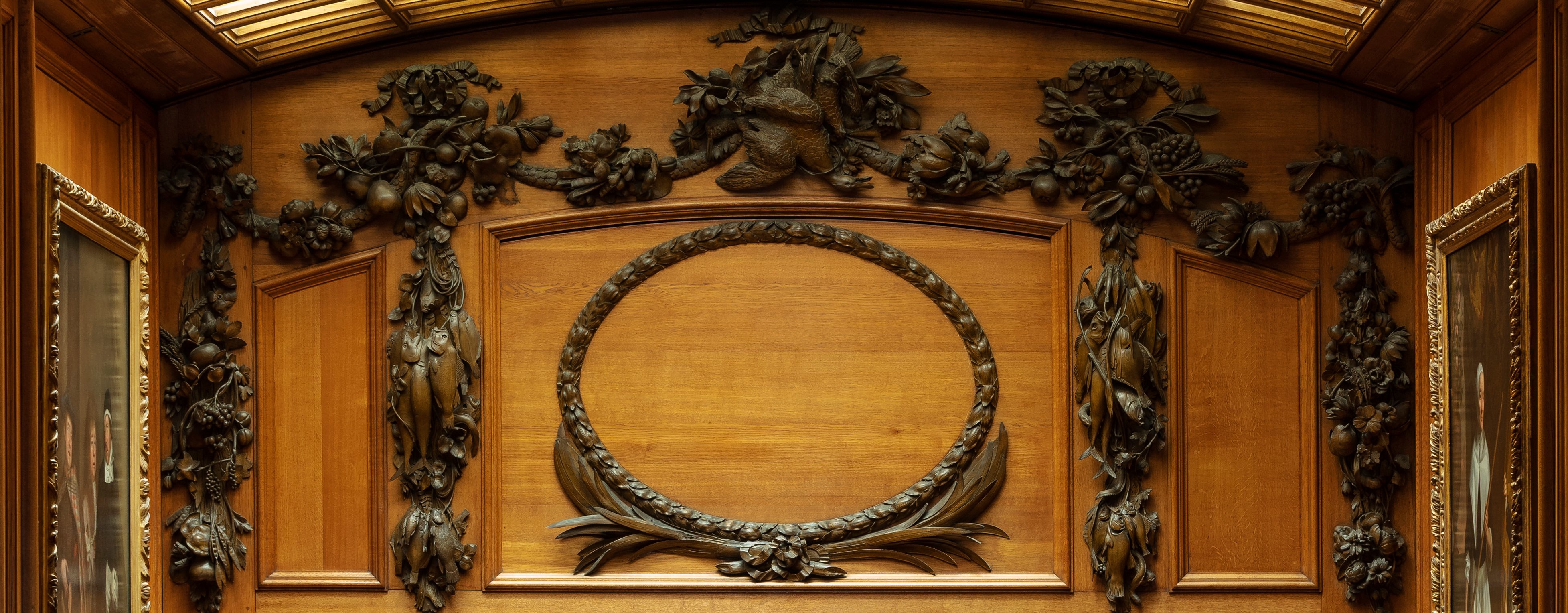
Grinling Gibbons
Royal Master Carver
GRINLING GIBBONS (1648-1721)
Charles II, 1630-1685
1678-79Bronze (statue). Portland stone (pedestal). Marble (low relief panels). | 888 cm (Height) (whole object) | RCIN 31958
A statement of loyalty to the King and to the royalist cause, this equestrian statue was commissioned for the Upper Ward at Windsor Castle by Tobias Rustat, valet to King Charles II and the most significant charity benefactor of the period. Some of Rustat's wealth came from the Royal African Company, a transatlantic slave trading organisation, in which he invested, and in which he was involved administratively between 1676 and 1680. The statue is the work of Grinling Gibbons, the Dutch woodcarver and sculptor working in England, appointed ‘Surveyor and Repairer of Carved Work at Windsor’ in 1682, and it was cast by the founder Josias Ibach whose signature is inscribed on the horse’s back left hoof ‘Josias Ibach Stada Bramesis 1679 FUDIT’.
Very innovative in its design, the statue excludes any reference to national symbols – like the insignia of the Garter - and contemporary fashion of the period. Charles II is depicted instead like a Roman emperor, 'all’antica' style, crowned with a laurel wreath, wearing a suit of classical armour without spurs and stirrups, and with classical cropped hair. It has been suggested that the equestrian statue of the Roman emperor Marcus Aurelius in the Capitoline Hill - 'Campidoglio' - may have been a source of inspiration, from which the stepped plinth and position of the horse derive.
This depiction of Charles II as a Roman laureate hero set a trend for subsequent monarchs, as late as George IV, who liked to be portrayed in the same classical 'manner of Gibbons'.
The statue rests on a rectangular Portland stone plinth with marble reliefs on the sides which are also attributed to Gibbons because of the clear similarities in design and style with the wood carvings that he is mostly famous for. The front panel bears an inscription. The other three low reliefs depict the arms of England, Scotland and Ireland and their symbols inlcude allusions to England’s marine dominance and prowess at sea, the stability of the Monarchy and the role of the King Charles II as patron of the arts.
This is one of three statues of King Charles II made by Gibbons. Of the other two, one is also an equestrian tribute to Charles II. It was commissioned by the Edinburgh Town Hall and is thought to be the oldest lead-cast equestrian statue in Britain.
Very innovative in its design, the statue excludes any reference to national symbols – like the insignia of the Garter - and contemporary fashion of the period. Charles II is depicted instead like a Roman emperor, 'all’antica' style, crowned with a laurel wreath, wearing a suit of classical armour without spurs and stirrups, and with classical cropped hair. It has been suggested that the equestrian statue of the Roman emperor Marcus Aurelius in the Capitoline Hill - 'Campidoglio' - may have been a source of inspiration, from which the stepped plinth and position of the horse derive.
This depiction of Charles II as a Roman laureate hero set a trend for subsequent monarchs, as late as George IV, who liked to be portrayed in the same classical 'manner of Gibbons'.
The statue rests on a rectangular Portland stone plinth with marble reliefs on the sides which are also attributed to Gibbons because of the clear similarities in design and style with the wood carvings that he is mostly famous for. The front panel bears an inscription. The other three low reliefs depict the arms of England, Scotland and Ireland and their symbols inlcude allusions to England’s marine dominance and prowess at sea, the stability of the Monarchy and the role of the King Charles II as patron of the arts.
This is one of three statues of King Charles II made by Gibbons. Of the other two, one is also an equestrian tribute to Charles II. It was commissioned by the Edinburgh Town Hall and is thought to be the oldest lead-cast equestrian statue in Britain.







